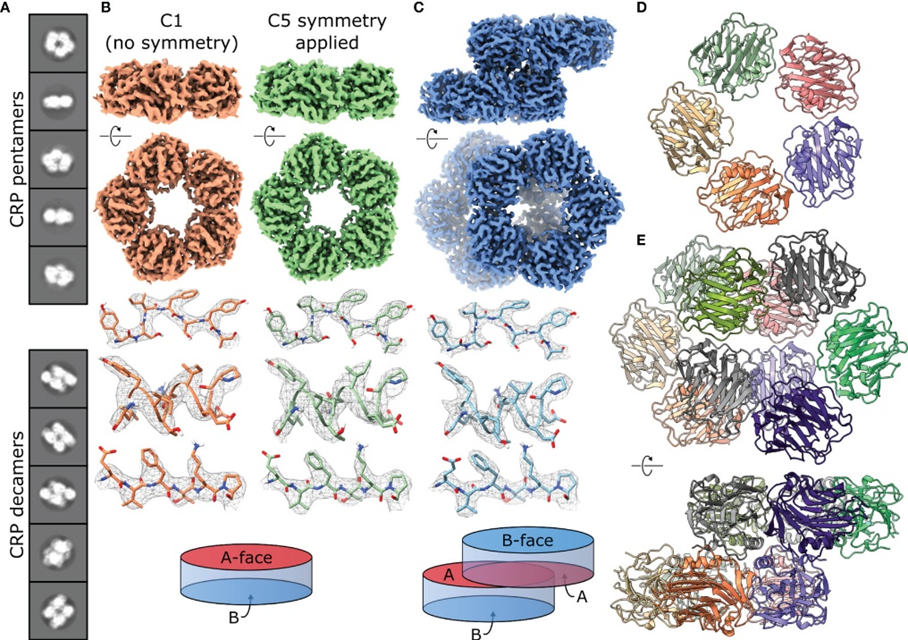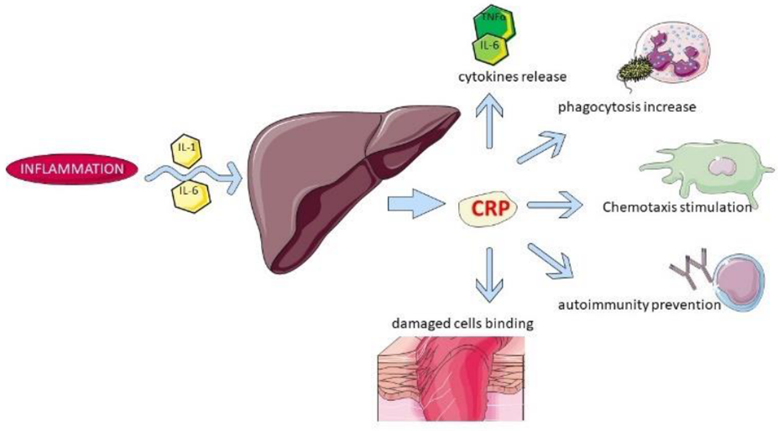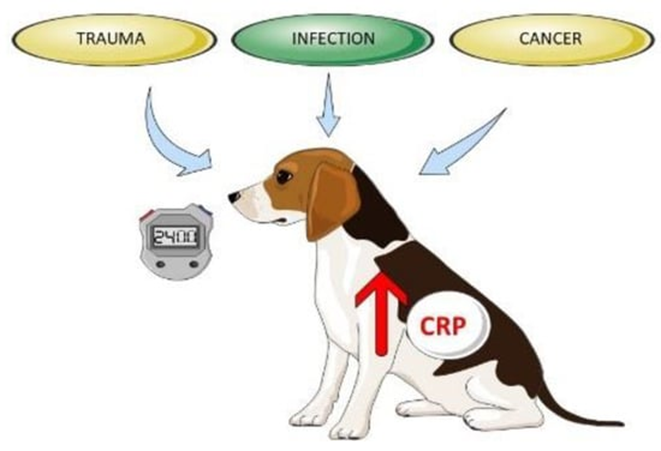Sushant Sadotra
The acute phase response (APR) is the early typical systemic response prompted by homeostasis disturbances such as injuries, infection, neoplasia, and other pathologies. Acute phase proteins get released from the liver into the blood after such stimulations. Therefore, elevated levels of such proteins can be used to indicate systemic inflammation. C-reactive protein, also called CRP, is an acute-phase protein synthesized in the liver and acts as a marker of the innate immune system response during inflammatory reactions. It is a 120 kDa composed of five identical subunits to form a pentamer structure.

In Dogs, proinflammatory cytokines cause a rapid rise in the blood CRP concentration that also returns to normal without the provocative cause. Therefore it serves as an indicator and a crucial biomarker of inflammation. Besides projecting the degree of inflammation, CRP is helpful as a marker to examine the severity of a specific disease, such as gastrointestinal issues or diseases of other organs. Some of the biological functions of CRP are mentioned below:

Factors inducing acute phase response, including CRP:

CRP has been widely used in Europe and Japan to examine dogs with gastrointestinal and nongastrointestinal disorders.
Some of the pathophysiologic conditions where CRP is frequently used as a biomarker are:
- Chronic inflammatory enteropathy:
CRP is a marker for chronic gastrointestinal signs, mucosal inflammation, systemic or gastrointestinal diseases, etc.
- Acute pancreatitis:
Measurement of CRP and pancreatic lipase provide more sensitive and specific results.
- Parvovirus infection:
CRP can provide predictive information in dogs with CPV-2 infection.
- Hepatic disease:
Dogs with hepatic disease have shown evaluated serum CRP levels.
- Acute abdomen:
CRP is also the indicator of an acute abdomen in dogs with symptoms of abdominal pain, gastric dilatation or volvulus, small bowel obstruction, and peritonitis.
- Protein-losing enteropathy:
CRP concentrations are higher in dogs with PLE, a disorder where excessive protein loss occurs through gastrointestinal mucosa.
- Immune-mediated hemolytic anemia:
Dogs with Immune-mediated hemolytic anemia have high CRP levels.
- Cancer:
Tumor-associated inflammation or cytokine production leads to higher CRP concentrations in dogs with cancer of hematopoietic origins, such as lymphoma and leukemia.
Measurement of canine CRP:
- Point-of-care Tests:
POCTs track the inflammatory response in dogs as a rapid ancillary test or emergency. Evaluating CRP levels can be tested using available POCTs like the Point Strip canine CRP assay, LifeAssays canine CRP test, EURO-Lyser solo CRP test, and TECOdogCRP-quant.
- Laser Nephelometric Immunoassay:
This commercially available test can estimate the scattering of light from a laser interacting with the CRP and anti-canine CRP antibody complex. This test is developed as Laser CRP-2 by Arrows Co., Ltd., Osaka, Japan.
- CRP ELISA Test:
Many laboratories can estimate CRP at a large scale using commercially available multiple canine-specific CRP ELISA Tests such as Phase Range canine CRP ELISA37 (developed by Tridelta Development Ltd, Kildare, UK) and test invented by Waritani et al.
- Automated Immunoturbidimetric Assays:
Measurement of CRP in dogs can also be done through many automated immunoturbidimetric assays like the Turbovet canine CRP assay by Acuvet Biotech, Zaragoza, Spain; the Gentian canine CRP assay by Gentian AS, Moss, Norway; and TR-IMFA developed by Parra et al.
Reference:
- Noone, Dylan P et al. “Cryo-Electron Microscopy and Biochemical Analysis Offer Insights Into the Effects of Acidic pH, Such as Occur During Acidosis, on the Complement Binding Properties of C-Reactive Protein.” Frontiers in immunology vol. 12 757633. 16 Dec. 2021, doi:10.3389/fimmu.2021.757633
- Malin, Katarzyna, and Olga Witkowska-Piłaszewicz. “C-Reactive Protein as a Diagnostic Marker in Dogs: A Review.” Animals : an open access journal from MDPI vol. 12,20 2888. 21 Oct. 2022, doi:10.3390/ani12202888
- Covin, Marshal A, and Joerg M Steiner. “Measurement and clinical applications of C-reactive protein in gastrointestinal diseases of dogs.” Veterinary clinical pathology vol. 50 Suppl 1,Suppl 1 (2022): 29-36. doi:10.1111/vcp.13100

